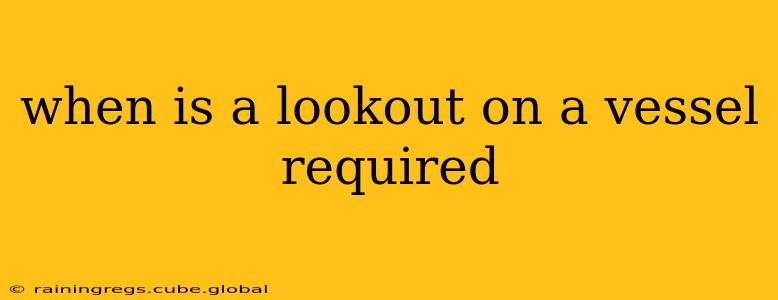When is a Lookout on a Vessel Required?
The requirement for a lookout on a vessel isn't a simple yes or no answer. It depends heavily on several factors, primarily the size and type of vessel, the prevailing conditions, and the applicable regulations. This post will delve into the specifics, answering common questions surrounding lookout requirements.
Understanding the Purpose of a Lookout
Before discussing the specifics of when a lookout is required, it's crucial to understand why a lookout is essential. A properly positioned and attentive lookout serves as an extra pair of eyes, significantly enhancing the vessel's ability to avoid collisions and other hazards. Their primary role is the early detection of other vessels, obstructions, and potential dangers not readily apparent to the bridge team. This early warning system is paramount to safe navigation.
What are the Regulations Regarding Lookouts?
The most widely recognized international regulations regarding lookouts are enshrined in the International Regulations for Preventing Collisions at Sea (COLREGs), specifically Rule 5. This rule mandates that every vessel shall at all times maintain a proper look-out by sight and hearing as well as all available means appropriate in prevailing circumstances and conditions. This means the responsibility doesn't just fall on one individual but requires a holistic approach.
However, COLREGs don't explicitly state a number of lookouts required. The number depends on factors we’ll discuss below.
What Types of Vessels Require a Dedicated Lookout?
The need for a dedicated lookout varies considerably. Here’s a breakdown:
-
Large Vessels: Large commercial vessels, tankers, cargo ships, and passenger ships are almost always required to have designated lookouts, especially in restricted visibility or busy shipping lanes. The size and maneuverability of these vessels necessitate a heightened level of awareness.
-
Smaller Vessels: Smaller vessels, like fishing boats, yachts, and smaller commercial craft, may not always require a dedicated lookout. However, the master or person in charge still has the ultimate responsibility for maintaining a proper lookout. This may involve the master personally performing lookout duties or delegating the responsibility to a crew member while maintaining overall situational awareness.
-
Specific Conditions: Even small vessels might require a dedicated lookout in specific situations, such as:
- Restricted visibility: Fog, heavy rain, or night navigation significantly reduces visibility and necessitates a dedicated lookout.
- Heavy traffic: Navigating busy waterways or harbors demands extra vigilance and often necessitates a dedicated lookout.
- Complex navigational situations: Navigating narrow channels, congested areas, or areas with significant currents or tidal changes may require a lookout.
What if I'm Alone on a Small Vessel?
If you're the sole person on board a smaller vessel, you are responsible for maintaining a proper lookout. This requires diligent observation and using all available means (radar, AIS, etc.) to increase awareness.
How Do I Determine the Adequacy of My Lookout System?
The adequacy of your lookout system depends on a holistic assessment:
- Visibility: Consider the prevailing weather conditions and any limitations to visibility.
- Traffic Density: The number of vessels and other traffic present.
- Vessel Size and Maneuverability: Larger vessels require a more robust lookout system.
- Complexity of the Navigation: Navigating complex areas requires more attention.
- Available Technology: Utilizing radar, AIS, and other electronic aids can supplement visual observation.
In Conclusion:
While COLREGs mandate a proper lookout, the specifics of what constitutes "proper" and whether a dedicated lookout is needed are determined by a case-by-case assessment. Prioritizing safety and maintaining situational awareness through visual observation, and utilizing available technology, is paramount. Always err on the side of caution, particularly in challenging conditions. Ignoring lookout requirements can lead to serious accidents and legal consequences.
